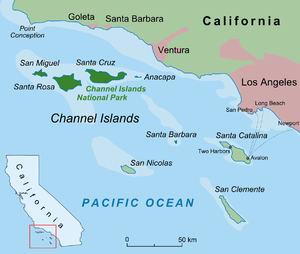Catalina Airport
| Catalina Airport Buffalo Springs Airport | |||||||||||
|---|---|---|---|---|---|---|---|---|---|---|---|
|
Aerial view of the airport from the East. | |||||||||||
|
Catalina Airport runway diagram | |||||||||||
|
IATA: AVX[1] – ICAO: KAVX – FAA LID: AVX – WMO: 72292 | |||||||||||
| Summary | |||||||||||
| Airport type | Public | ||||||||||
| Owner | Catalina Island Conservancy | ||||||||||
| Serves | Avalon, Catalina Island, California | ||||||||||
| Location | Avalon, California | ||||||||||
| Elevation AMSL | 1,602 ft / 488 m | ||||||||||
| Coordinates | 33°24′18″N 118°24′57″W / 33.40500°N 118.41583°W | ||||||||||
| Map | |||||||||||
 KAVX Location of Catalina Airport | |||||||||||
| Runways | |||||||||||
| |||||||||||
| Statistics (2006) | |||||||||||
| |||||||||||
Catalina Airport (IATA: AVX, ICAO: KAVX, FAA LID: AVX) is a privately owned airport located six miles (10 km) northwest of the central business district of Avalon, California[2] in the middle of Catalina Island. The airport is open to the public and allows general aviation aircraft to land there. The only requirement is that inbound pilots state their intention to land and that they pay a $25 landing fee.[3] The airport is primarily used for general aviation. The airport is also used for airfreight from the mainland. Supplies for the island are delivered via Douglas DC-3 aircraft daily.
The airfield is also known as the Airport in the Sky due to the fact it lies near the island's highest point at an elevation of 1,602 ft (488 m) All roads to the airport from the island's population centers climb steeply upward.[4]
The airport currently has no scheduled passenger service.
History
The airport originally opened as Buffalo Springs Airport in the spring of 1941. It was built by the Wrigley family of Chicago, who owned most of the island under the Santa Catalina Island Company, by leveling off the top of a hill.[5] Prior to this, only seaplanes landed at Hamilton Cove Seaplane Base, just north of Avalon. The Wrigleys kept a DC-3 in the large hangar there.
World War II
In the autumn of 1942 the United States Army Air Forces (USAAF) took control of the Buffalo Springs Airport for the duration of World War II, to support Army, Navy, Coast Guard, the Maritime Service, and the Office of Strategic Services (OSS) activities on the island.
It also was a USAAF Fourth Air Force Replacement Training Station. Administratively, the airfield operated as a sub-base of March Field located in Riverside County.
Former commercial flights

In the early 1950s, United Airlines served the airport with scheduled passenger service with nonstop flights to Long Beach Airport (LGB) and direct, one stop service to Los Angeles International Airport (LAX) operated with Douglas DC-3 aircraft.[6] During the mid 1950s, Catalina Air Lines was operating de Havilland Dove twin prop aircraft on nonstop flights to Los Angeles International and Burbank Airport (BUR, now Bob Hope Airport).[7] By the late 1950s, Pacific Air Lines was providing flights with Douglas DC-3 aircraft to Los Angeles International, Long Beach Airport, and Burbank Airport.[8]
In the late 1960s, Catalina-Vegas Airlines was operating nonstop service to San Diego Lindbergh Field (SAN).[9]
Golden West Airlines provided flights as well during the early 1970s with de Havilland Canada DHC-6 Twin Otter short takeoff and landing STOL capable twin turboprop aircraft with nonstop service to LAX and Orange County Airport (SNA, now John Wayne Airport).[10] Golden West also acquired Catalina Air Lines which served the island with seaplane flights operated from Avalon and Two Harbors.
- Film shoots
Some exterior shots in the movie The In-Laws were shot at Catalina Airport, it doubling as a rural Latin airport.[11] The tower is readily identifiable.
Catalina Island Conservancy
The airport is now owned by the Catalina Island Conservancy which lets charter planes fly into the airport.
While landing at the airport a private Learjet landed overshot Runway 22, killing six people. After that the Catalina Island Conservancy has limited the number of planes allowed to use the airport.
Gallery
-

Catalina Airport's DC 3 hangar
-

The tower in 2013
-

Catalina Airport from the runway
-

Catalina Island interior
-

Airport aerial view from the West
References
![]() This article incorporates public domain material from the Air Force Historical Research Agency website http://www.afhra.af.mil/.
This article incorporates public domain material from the Air Force Historical Research Agency website http://www.afhra.af.mil/.
- ↑ "Airline and Airport Code Search". IATA. Retrieved 15 October 2015.
- 1 2 FAA Airport Master Record for AVX (Form 5010 PDF), retrieved 15 March 2007
- ↑ http://catalina.com/the-airport-in-the-sky/
- ↑ Catalina Island - Airport Information
- ↑ California State Military Museum: History of the Buffalo Springs Airport, Catalina Island
- ↑ Jan. 4, 1953 United Air Lines system timetable
- ↑ June 20, 1955(?) Catalina Airlines system timetable
- ↑ Dec. 1, 1959 Pacific Air Lines system timetable
- ↑ 1968 Catalina-Vegas system timetable
- ↑ http://www.timetableimages.com, June 1972 & Jan. 1, 1973 Golden West Airlines system timetables
- ↑ IMDB Shooting Locations: The In-Laws
External links
- Resources for this airport:
- FAA airport information for AVX
- AirNav airport information for KAVX
- ASN accident history for AVX
- FlightAware airport information and live flight tracker
- NOAA/NWS latest weather observations
- SkyVector aeronautical chart, Terminal Procedures


.svg.png)